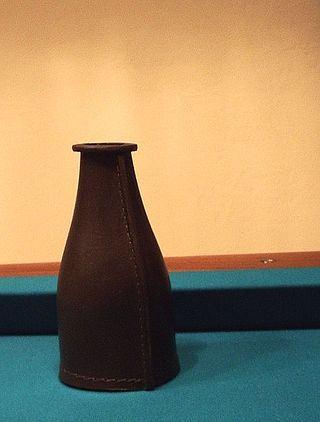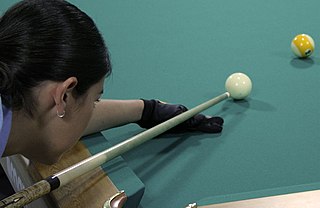
Cue sports are a wide variety of games of skill played with a cue, which is used to strike billiard balls and thereby cause them to move around a cloth-covered table bounded by elastic bumpers known as cushions.

Eight-ball is a discipline of pool played on a billiard table with six pockets, cue sticks, and sixteen billiard balls. The object balls include seven solid-colored balls numbered 1 through 7, seven striped balls numbered 9 through 15, and the black 8 ball. After the balls are scattered with a break shot, a player is assigned either the group of solid or striped balls once they have legally pocketed a ball from that group. The object of the game is to legally pocket the 8-ball in a "called" pocket, which can only be done after all of the balls from a player's assigned group have been cleared from the table.

Nitrocellulose is a highly flammable compound formed by nitrating cellulose through exposure to a mixture of nitric acid and sulfuric acid. One of its first major uses was as guncotton, a replacement for gunpowder as propellant in firearms. It was also used to replace gunpowder as a low-order explosive in mining and other applications. In the form of collodion it was also a critical component in an early photographic emulsion, the use of which revolutionized photography in the 1860s.
Celluloids are a class of materials produced by mixing nitrocellulose and camphor, often with added dyes and other agents. Once much more common for its use as photographic film before the advent of safer methods, celluloid's common contemporary uses are for manufacturing table tennis balls, musical instruments, combs, office equipment, fountain pen bodies, and guitar picks.

English billiards, called simply billiards in the United Kingdom and in many former British colonies, is a cue sport that combines the aspects of carom billiards and pool. Two cue balls and a red object ball are used. Each player or team uses a different cue ball. It is played on a billiards table with the same dimensions as one used for snooker and points are scored for cannons and pocketing the balls.

Straight pool, which is also called 14.1 continuous and 14.1 rack, is a cue sport in which two competing players attempt to pot as many billiard balls as possible without playing a foul. The game was the primary version of pool played in professional competition until it was superseded by faster-playing games like nine-ball and eight-ball in the 1980s.

A billiard ball is a small, hard ball used in cue sports, such as carom billiards, pool, and snooker. The number, type, diameter, color, and pattern of the balls differ depending upon the specific game being played. Various particular ball properties such as hardness, friction coefficient, and resilience are important to accuracy.

Carom billiards, also called French billiards and sometimes carambole billiards, is the overarching title of a family of cue sports generally played on cloth-covered, pocketless billiard tables. In its simplest form, the object of the game is to score points or "counts" by caroming one's own cue ball off both the opponent's cue ball and the object ball on a single shot. The invention as well as the exact date of origin of carom billiards is somewhat obscure but is thought to be traceable to 18th-century France.

A billiard table or billiards table is a bounded table on which cue sports are played. In the modern era, all billiards tables provide a flat surface usually made of quarried slate, that is covered with cloth, and surrounded by vulcanized rubber cushions, with the whole thing elevated above the floor. More specific terms are used for specific sports, such as snooker table and pool table, and different-sized billiard balls are used on these table types. An obsolete term is billiard board, used in the 16th and 17th centuries.

Pool is a classification of cue sports played on a table with six pockets along the rails, into which balls are shot. Each specific pool game has its own name; some of the better-known include eight-ball, blackball, nine-ball, ten-ball, seven-ball, straight pool, one-pocket, and bank pool. Eight-ball is the most frequently played discipline of pool, and is often thought of as synonymous with "pool".

John Wesley Hyatt was an American inventor. He is mainly known for simplifying the production of celluloid.
The following is a glossary of traditional English-language terms used in the three overarching cue sports disciplines: carom billiards referring to the various carom games played on a billiard table without pockets; pool, which denotes a host of games played on a table with six pockets; and snooker, played on a large pocket table, and which has a sport culture unto itself distinct from pool. There are also games such as English billiards that include aspects of multiple disciplines.

Tom Reece was an English professional player of English billiards. He was six times runner-up in the professional billiards championship, now regarded as the world championship, losing three times to Melbourne Inman in finals from 1912 to 1914, and three times to Tom Newman in the 1921, 1924 and 1925 finals. He made the unofficial world's highest billiards break of 499,135 in 1907 using a cradle cannon technique shortly before it was banned from the sport. In 1927, his prowess with the pendulum stroke led to that also being banned from use in competition.

Bottle pool, also known as bottle-billiards and bottle pocket billiards, is a hybrid billiards game combining aspects of both carom billiards and pocket billiards. Played on a standard pool table, the game uses just two object balls, a cue ball, and a 6+3⁄4 inches (170 mm) tall, narrow-necked bottle called a shake bottle or tally bottle, traditionally made from leather, that is placed on the table and used as a target for caroms. Those unfamiliar with the game sometimes mistakenly use its name as a synonym for the very different game of kelly pool. Bottle pool has been described as combining "elements of billiards, straight pool and chess under a set of rules that lavishly rewards strategic shot making and punishes mistakes with Sisyphean point reversals."
Carom billiards and pool are two types of cue sports or billiards-family games, which as a general class are played with a stick called a cue which is used to strike billiard balls, moving them around a cloth-covered billiard table bounded by rubber cushions attached to the confining rails of the table.
American snooker is a cue sport played almost exclusively in the United States, and strictly on a recreational, amateur basis. Diverging from the original game of snooker, rules for American snooker date back to at least 1925, and have been promulgated by the Billiard Congress of America (BCA) since the mid-20th century. The game is in decline, as the standardized international rules have largely supplanted it.

A cue stick is an item of sporting equipment essential to the games of pool, snooker and carom billiards. It is used to strike a ball, usually the cue ball. Cues are tapered sticks, typically about 57–59 inches long and usually between 16 and 21 ounces (450–600 g), with professionals gravitating toward a 19-ounce (540 g) average. Cues for carom tend toward the shorter range, though cue length is primarily a factor of player height and arm length. Most cues are made of wood, but occasionally the wood is covered or bonded with other materials including graphite, carbon fiber or fiberglass. An obsolete term for a cue, used from the 16th to early 19th centuries, is billiard stick.
Crystalate Manufacturing Company Ltd. was a British plastics and later electronic components manufacturing company that operated in one form or another from August 1901 through August 1990. It is best known for its gramophone records made of moulded Crystalate plastic.
The Albany Billiard Ball Company was an American manufacturer of billiard balls based in Albany, New York. The company was founded in 1868, manufacturing for over 100 years, before going out of business in 1986.
E.J. Riley, later Riley Leisure and just Riley, is a British sporting goods brand founded in 1878 by Edward John Riley, an Irish expatriate living in Manchester, England.












